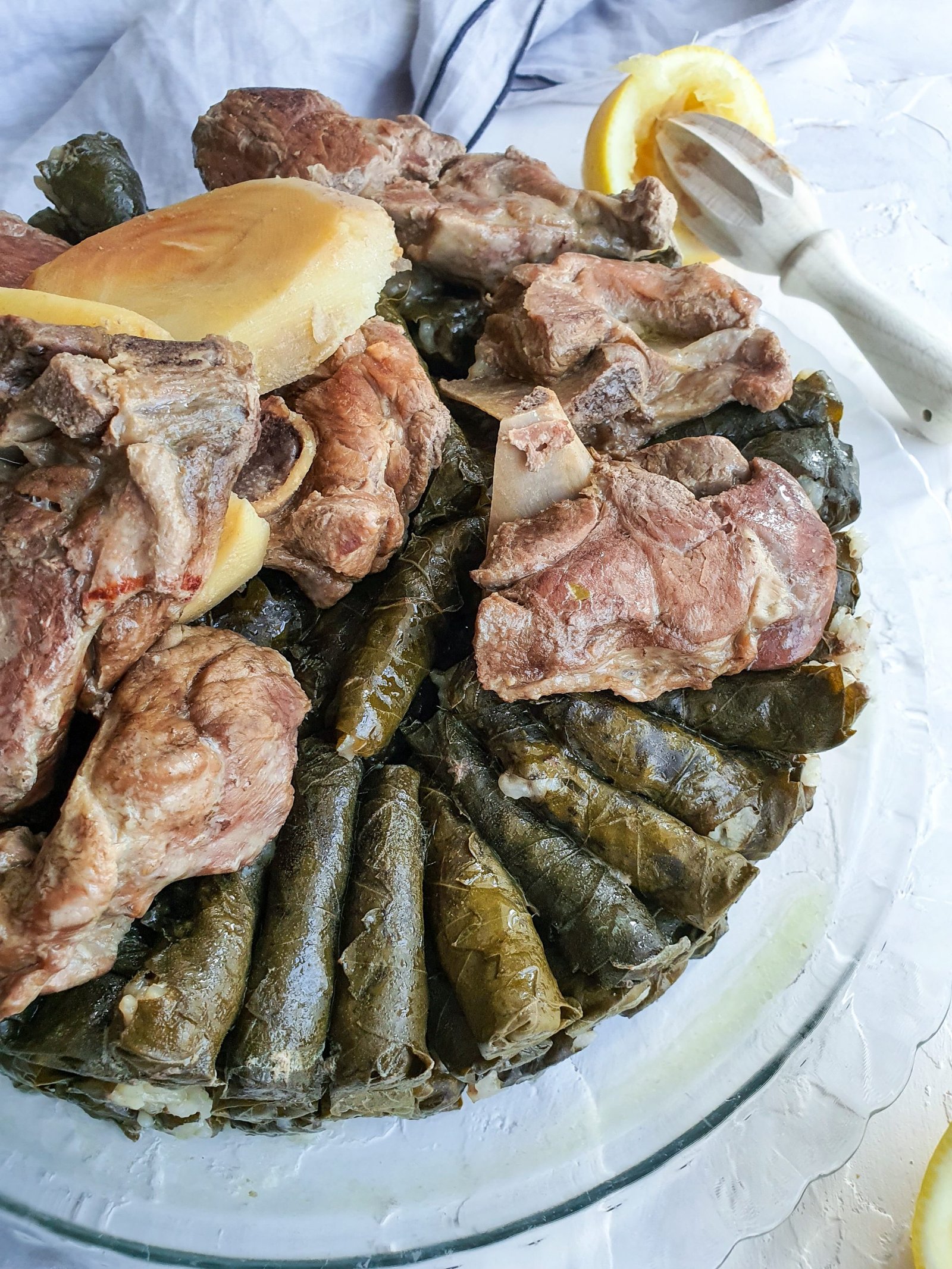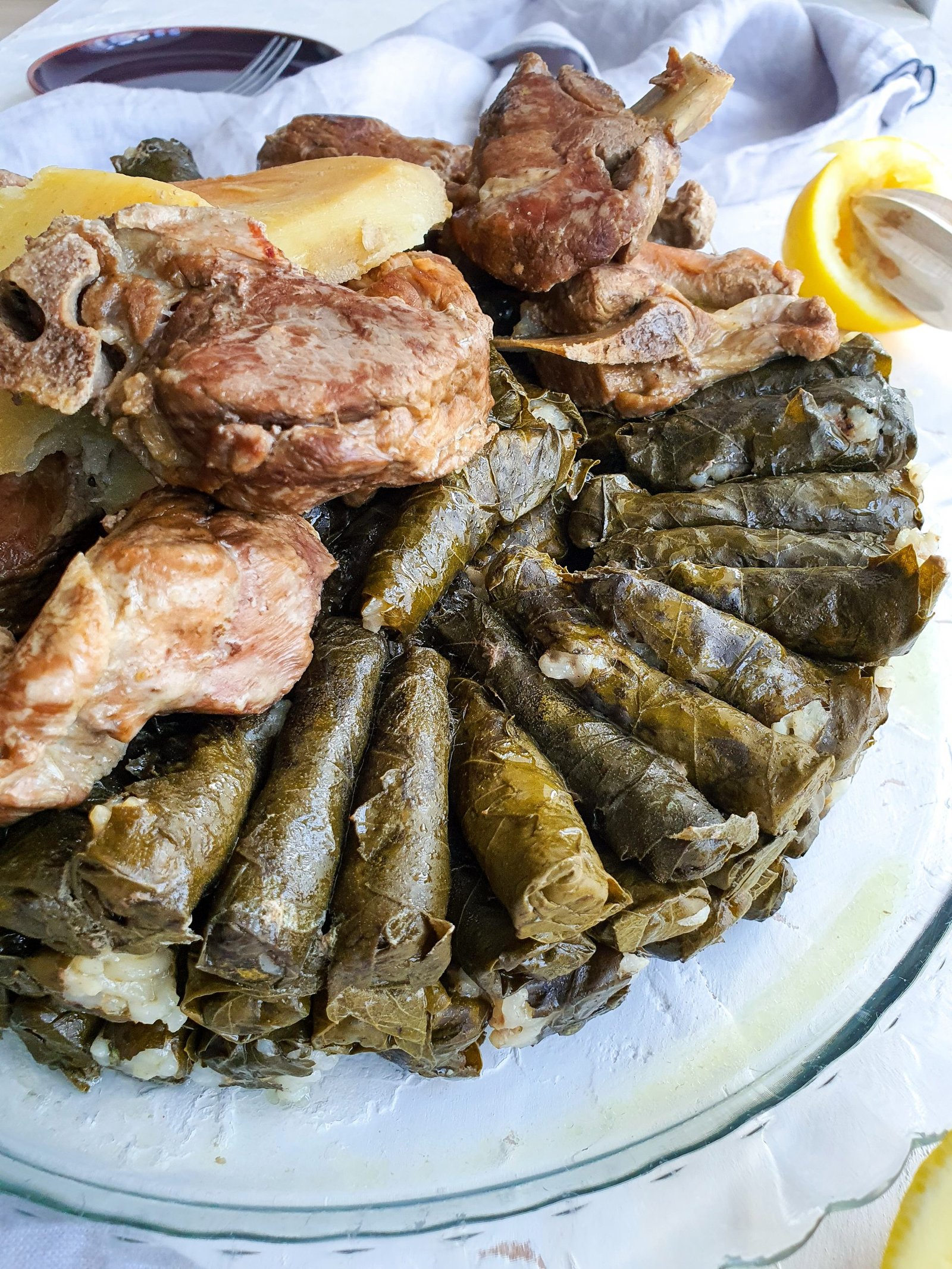An absolute favourite of many, not just Middle Easterners! This is a little different from the traditional Dolma. My Syrian Khale (aunt) always makes the best Syrian Stuffed Vine Leaves (Warak Enab) and once the serving dish is placed on the table, you will find us glued to the table until every last delicious Warak Enab is devoured. I cannot put into words how great this recipe is because I simply wouldn’t do it justice. The best thing to do is try these stuffed vine leaves for yourself!
I would say this is a very authentic recipe. I have only made a few tweaks in terms of increasing the spices, adding more garlic, and using onions and potatoes when layering the rolls. The stuffed Warak Enab are made with mince meat inside the rolls but if you choose to make it vegetarian, simply remove the meat and cook with just water or even better, stock!
Meat Stuffed Warak Enab! An Iconic Syrian Dish!

Tons of Variety for Grape Leaves!
There is no ‘one-and-only’ filling, traditionally called hashwa for vine leaves. There are several versions, and each and every one of them has its unique hearty flavours that you just can’t get enough off! I’ve listed a few variations below made in a variety of different countries:
- Turkish dolmas or yaprak sarmasi
- Persian dolmeh
- Syrian grape leaves or yabrak
- Lebanese stuffed grape leaves
- Vegetarian stuffed vines; Warak Enab Bil Zet aslo called Yalanji
Perfectly Rolled and Cooked Grape Leave!

How to Perfect Your Syrian Stuffed Vine Leaves (Warak Enab)
The recipe for making Warak Enab is simple, but I would say that the technique and the little tips and tricks are what make or break it.
You have to roll each leaf into an elegant thin wand shape but be careful to not roll them so tight because the rice needs to expand while it cooks.
Slowly pour water in the pot so it goes between the layers of stuffed vine leaves, lamb, and veggies.
Place a heavy plate on top of the rolls so that they don’t get a chance to swim around and become unwrap themselves.
I’ve added the right amount of filling in the recipe below so that the Warak Enab do not overfill and break during the rolling and cooking process. Check the recipe card for more details.
Juicy, Tender, Tantalizing Stuffed Grape Leaves

Frequently Asked Questions
Can I stuff the vine leaves and layer them in the pot but not cook them?
If you want to save time, you can do so. Keep them in the fridge but no longer than 2 days.
Is warak enab and dolma the same?
Warak Enab is an Arabic word that literally translates into grape leaves. Stuffed Warak Enab is commonly knows as dolma, the Greek name for this dish.
What can I do with stuffed vine leaves leftovers?
You can keep them in an airtight container in the fridge for 4- 5 days. If you want to keep them longer, set the container in the freezer and it may last up to 2 months.
Stuffed Waral Enab, My All-Time Favorite Meal

Syrian Stuffed Vine Leaves
Ingredients
- Grape leaves
- Short grain or Arabic rice
- Minced lamb or beef
- Lamb with bones
- Olive oil
- Ghee
- Lemon
- Black pepper
- Arabic 7 spices
- Salt
- Crushed garlic
- Whole garlic
- Large onion
- Large potato
Get Ready for the Stuffed Vine Leaves
Prepare warak enab and the stuffing.
First, remove the leaves from the packaging, soak in warm tap water and slowly peel them apart.
Then, fill a medium pot with boiling water and allow the leaves to boil in there for 2 minutes. Drain and immediately replace the boiling water with cold tap water. Allow to sit for a minute before draining the leaves. They are now ready to roll.
For the stuffing, wash the rice and soak in boiling water for 10 minutes (do not parboil or leave it longer). Then, drain the rice and mix with meat, garlic, seasoning, ghee and 3 tablespoons of olive oil. Combine the mixture, and the filling is ready.
It is rolling and layering time.
At the very base of the pot, place one layer of the onion slices, followed by the potato and then the chunks of lamb on bone.
Start rolling – take off the stem of the leaf and place the side with the veins on the inside of the roll where the mixture will be placed.
For each roll, take less than half a tea spoon of the mixture. Place the spoonful in the center and shape it into a line across the leaf. Fold the sides of the leaf in, over the filling, and roll the leaf until the end and it seals together.
Place the rolls tightly alongside one another in the pot on top of the lamb chunks until the pot has filled to the top. Leave a 3cm gap at the top of the pot.
It’s cooking time..
First, place the pot on the smallest fire on the cooker and have the heat on medium. Drizzle the rest of the olive oil all over the rolls (maybe even some extra – be generous with this).
Place a heavy plate on top of the rolls and place a large cereal bowl filled with water on top of the plate. This is just to create pressure and stop the rolls from floating around in the pot. Boil water and slowly pour enough water into the pot until the vine leaves are covered.
Wait for the water covering the rolls to start boiling. Turn the heat down to the lowest setting and remove the cereal bowl. Leave the plate in the pot until the very end; it is important you do not remove this. Now place a lid on the pot.
Total cooking time in the pot will be around 2 hours. When the water starts to dry, check the rolls. If the leaves are soft to the bite and the rice is cooked, then switch off the heat and remove the plate. Squeeze a whole lemon all over the rolls.
If they are not cooked, add 1 cup of water at a time until it cooks. Keep a close eye as you don’t want your delicious Warak Enab leaves to burn.
If the rolls cook before all the water is dried up, you can gently tilt the pot while creating a little gap with the lid and drain the liquid. Don’t throw this away as it is very delicious. Feel free to drink it or pour over the Yabrak on your plate.
Popular Recipes You Should Try
- Kuku Sibzamini – Persian Boiled Potato Patties
- Homemade Turkish Lahmacun
- Havij Polo – Persian Jewelled Carrot Rice with Saffron Chicken
- Tahchin – Persian Saffron Rice with Chicken

Syrian Stuffed Vine Leaves (Warak Enab)
Ingredients
Instructions
-
Start by removing the leaves from the packaging, soak in warm tap water and slowly peel them apart.
-
Fill a medium pot with boiling water and allow the leaves to boil in there for 2 minutes. Drain and immediately replace the boiling water with cold tap water. Allow sitting for a minute before draining the leaves. They are now ready to roll.
-
Wash the rice and soak it in boiling water for 10 minutes (do not parboil or leave it longer). Drain the rice and mix it with meat, garlic, seasoning, ghee, and 3 tablespoons of olive oil. Combine the mixture, and the filling is ready.
-
Start layering the pot - at the very base place one layer of the onion slices, followed by the potato and then the chunks of lamb on bone.
-
Start rolling - take off the stem of the leaf and place the side with the veins on the inside of the roll where the mixture will be placed.
-
For each roll, take less than half a teaspoon of the mixture. Place it in the center and make a line, fold each side of the leaf in and roll the leaf until there's no leaf left and it seals together. Place the rolls tightly alongside one another in the pot on top of the lamb chunks until the pot has filled to the top. Leave a 3cm gap at the top of the pot.
-
Place the pot on the smallest fire on the cooker and have the heat on medium. Drizzle the rest of the olive oil all over the rolls (maybe even some extra be generous with this). Place a heavy plate on top of the rolls and place a large cereal bowl filled with water on top of the plate. (This is just to create pressure and stop the rolls from floating around in the pot.) Boil water and slowly pour enough water into the pot until the vine leaves are covered.
-
Wait for the water covering the rolls to start boiling. Turn the heat down to the lowest setting and remove the cereal bowl (leave the plate in the pot until the very end, it is important you do not remove this). Pace a lid on the pot.
-
The total cooking time in the pot will be around 2 hours. When the water starts to dry, check the rolls. If the leaves are soft to the bite and the rice is cooked then switch off the heat, remove the plate and squeeze a whole lemon all over the rolls.
-
If they are not cooked, add 1 cup of water at a time until it cooks. Keep a close eye as you don't want this to burn and ruin your hard work.
-
If the rolls cook before all the water is dried up, you can gently tilt the pot while creating a little gap with the lid and drain the liquid. Don't throw this away as it is very delicious. Feel free to drink it or pour it over the Yabrak on your plate.


